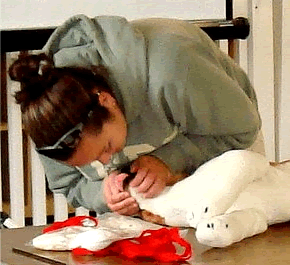It’s something we never think about – until it happens. Suddenly your dog is not breathing. Do you have any idea what to do? If you are certified for CPR for humans you may think, can I do the same thing to me dog safely? Who do I call?
First Response
As soon as you notice your dog is not breathing, do not move him.
“If there is airway obstruction [you] can turn [your dog] upside down to dislodge the trapped object,” says Dr. Babette Gladstein, who has been providing in-home traditional and holistic veterinary care for over thirty years.
Who do you Call?
When there is an emergency, our first thought is to call 911. But Dr. Gladstein said don’t call them for pets.
“Call your vet ASAP. [Ask if] they respond to calls regarding pets — there are house call vets- but time may be of the essence,” Dr. Gladstein says. “Otherwise just rush him to the nearest e-clinic.” But be sure to move him carefully – ask your vet on the phone how to move him the best way.
If your dog is too heavy and you cannot move him yourself, you may have to call 911, or a neighbor, for help. Just remember that with 911, your pet may not be their first priority. Ask them how long until someone can come.

Then What?
If you cannot get somewhere soon enough, or if you are waiting for help to arrive, Dr. Goldstein says to follow these steps:
1. Check mouth and throat — for a toy or bone- or swallowed object
2. Gently stretch the neck and tilt head slightly back try to breath
a. The bigger dog mouth should be closed so you can breath into there nose. Try this and give 2 breaths.
b. The smaller dogs or cats you can cover both nose and mouth– again breath 2 times.
3. Next – chest compression–the rate that you do this is size dependent
a. Bigger dogs can be on their back and compressed just like people.
b. Small dogs (or cats) can lie their side to compress the side of the rib cage.
Ratios of compressions to breaths is about the same as for humans – 30:2– which is done till the dog or cat breathes on its own.
Pet CPR Certification
Every dog owner should know pet CPR and First Aid. There are classes you can take to get certified on pet CPR, just like you do for humans. PetTech, for example, is the first international training center dedicated to CPR, First Aid and Care for dogs and cats. They have programs and instructors across the country. They site also has tips and news related to pet health.
The American Veterinary Medical Association is another good resource. They have the most up-to-date guidelines for CPR in dogs and cats.
